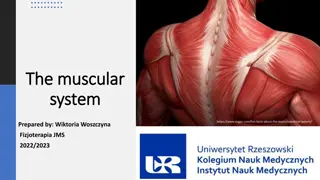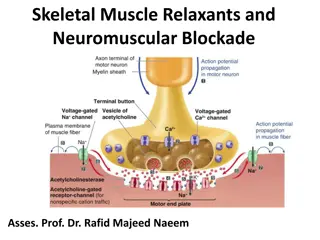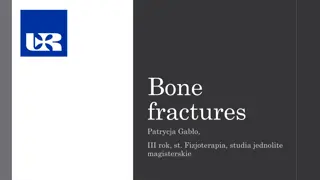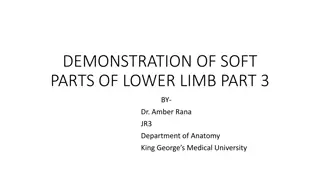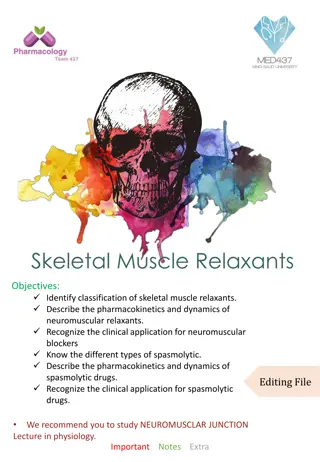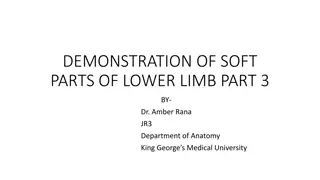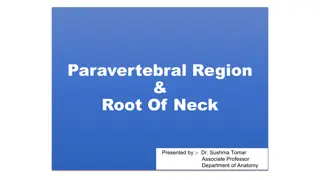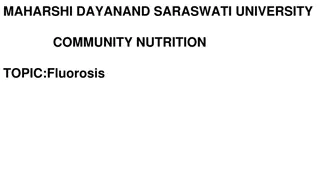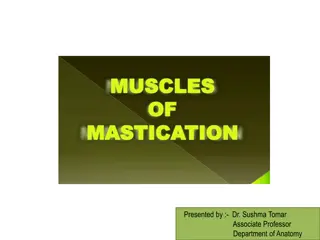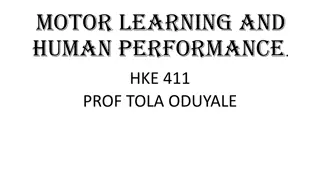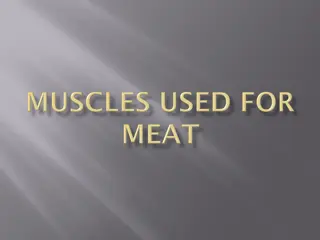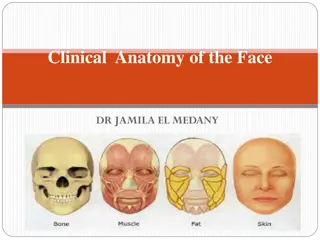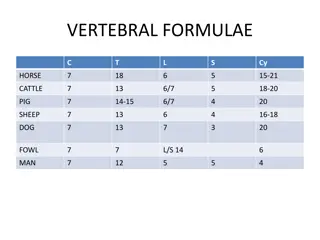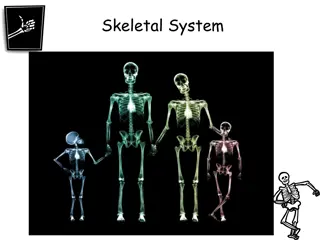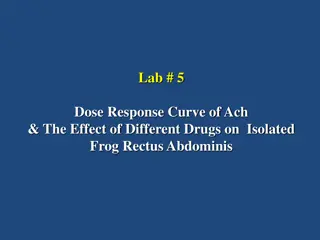
Skeletal Muscles: Features, Functions, and Types
Explore the main criteria of skeletal muscles, learn about muscle fiber directions, types of muscle attachments, and the muscular system. Understand the structure and function of skeletal muscles to enhance your knowledge in anatomy and physiology.
Download Presentation

Please find below an Image/Link to download the presentation.
The content on the website is provided AS IS for your information and personal use only. It may not be sold, licensed, or shared on other websites without obtaining consent from the author. If you encounter any issues during the download, it is possible that the publisher has removed the file from their server.
You are allowed to download the files provided on this website for personal or commercial use, subject to the condition that they are used lawfully. All files are the property of their respective owners.
The content on the website is provided AS IS for your information and personal use only. It may not be sold, licensed, or shared on other websites without obtaining consent from the author.
E N D
Presentation Transcript
Dr. Jamila EL Medany
OBJECTIVES OBJECTIVES At the end of the lecture, students should At the end of the lecture, students should be able to: be able to: Describe the Describe the main criteria main criteria of skeletal muscles. Describe the Describe the attachments attachments of skeletal muscles. Describe the Describe the different directions different directions of skeletal muscle fibers. muscle fibers. Describe the Describe the mode of action mode of action of skeletal muscles. Describe briefly the Describe briefly the naming naming of skeletal muscles. Describe briefly the Describe briefly the nerve supply nerve supply of skeletal muscles. muscles. of skeletal muscles. of skeletal muscles. of skeletal of skeletal muscles. of skeletal muscles. of skeletal
MUSCULAR SYSTEM C Composed of two main omposed of two main types : types : 1. Involuntary muscles: 1. Involuntary muscles: (a) (a) Smooth Smooth: Found in the walls of Found in the walls of viscera. viscera. (b) (b) Cardiac: Cardiac: Found only in the Heart. Found only in the Heart. 2. Voluntary (skeletal) 2. Voluntary (skeletal) muscles muscles SMOOTH SMOOTH SKELETAL SKELETAL CARDIAC CARDIAC
MAIN CRITERIA OF SKELTAL MUSCLES I I Striated. Striated. Attached to skeleton. Attached to skeleton. Produce movement Produce movement of skeleton. of skeleton. Voluntary Voluntary Supplied by Somatic Supplied by Somatic Nerves. Nerves.
THE DIRECTION OF MUSCLE FIBERS The range of motion and the power of a muscle depends on the arrangement of its fascicles. It can be: Circular Convergent Fusiform
DIRECTION OF MUSCLE FIBERS DIRECTION OF MUSCLE FIBERS Parallel Parallel to line of pull: to line of pull: More range of movement More range of movement, , (less powerful). (less powerful). Pennate Pennate (oblique to line of (oblique to line of pull): pull): More powerful More powerful, (less range of movement.) range of movement.) Unipennate Unipennate. . Bipennate Bipennate. . Multipennate Multipennate. . , (less parallel parallel 1. 1. 2. 2. 3. 3.
TYPES OF ATTACHMENT OF SKLETAL MUSCLES Muscles are attached to Muscles are attached to bones, cartilage or bones, cartilage or ligaments through: ligaments through: ( (1 1) Tendons ) Tendons : cords cords of fibrous tissue. of fibrous tissue. ( (2 2) ) Aponeurosis Aponeurosis : : A thin and A thin and strong sheet of strong sheet of fibrous tissue. fibrous tissue. ( (3 3) ) Raphe Raphe : : An An interdigitation interdigitation of the tendinous tendinous ends of the flat ends of the flat muscles. muscles. of the
DIFFERENCES BETWEEN ATTACHMENTS Number: (MOSTLY TWO) Number: (MOSTLY TWO) INSERTION INSERTION ORIGIN ORIGIN The The Proximal Proximal end end Mostly Mostly Fleshy Least Least Movable Movable, , The The Distal Mostly Mostly Fibrous Fibrous, , Most Most Movable, Movable, Distal end end Fleshy, ,
MODE OF ACTION (1) Prime mover (1) Prime mover (Agonist) : (Agonist) : It is the chief muscle It is the chief muscle responsible for a responsible for a particular movement particular movement Example Example: : Quadriceps Quadriceps Femoris the prime mover for the prime mover for extension of the knee extension of the knee joint. joint. Femoris is is
(2) Antagonist : (2) Antagonist : It opposes the action of It opposes the action of the prime mover. the prime mover. Before contraction of Before contraction of prime mover, the prime mover, the antagonist must be antagonist must be relaxed. relaxed. Example Example: : Biceps Biceps Femoris ( (Flexor of knee) Flexor of knee) It It opposes the action of opposes the action of quadriceps when the quadriceps when the knee joint is extended. knee joint is extended. Femoris
(3) Synergist : (3) Synergist : Prevents unwanted Prevents unwanted movement in an movement in an intermediate joint intermediate joint crossed by the Prime crossed by the Prime Mover. Mover. Example Example: : Flexors and Extensors Flexors and Extensors of wrist joint of wrist joint They contract to fix They contract to fix wrist joint in order that wrist joint in order that flexors and extensors flexors and extensors of fingers work of fingers work efficiently. efficiently.
( (4 4) ) Fixator Fixator : : Its contraction does not Its contraction does not produce movement by produce movement by itself but it stabilizes the itself but it stabilizes the origin of the prime mover origin of the prime mover so that it can act so that it can act efficiently. efficiently. Example Example: : Muscles attaching the Muscles attaching the shoulder girdle to the shoulder girdle to the trunk trunk contract to fix contract to fix shoulder girdle, allowing shoulder girdle, allowing deltoid muscle (taking deltoid muscle (taking origin from shoulder origin from shoulder girdle) to move shoulder girdle) to move shoulder joint ( joint (humerus humerus). ).
NAMING OF MUSCLES It is according to: It is according to: 1. Size: 1. Size: 1. 1. Major or Major or maximus 2. 2. Minor or Minor or minimus 3. 3. Latissimus Latissimus (broad). 4. 4. Longus Longus (long). 5. 5. Brevis Brevis (short). (short). 2. Position: 2. Position: 1. 1. Pectoralis Pectoralis (pectoral region) (pectoral region) 3. Depth: 3. Depth: 1. 1. Superficialis Superficialis (superficial). 2. 2. Profundus Profundus (deep). (deep). 3. 3. Externus Externus (external). (external). maximus (large). minimus (small). (broad). (long). (large). (small). (superficial).
4. Shape: 4. Shape: 1. 1. Deltoid Deltoid (triangular). 2. 2. Teres Teres (rounded) (rounded) 3. 3. Rectus Rectus (straight). (straight). 5. Number of Heads: 5. Number of Heads: 1. 1. Biceps Biceps (2 heads). (2 heads). 2. 2. Triceps Triceps (3 heads). (3 heads). 3. 3. Quadriceps Quadriceps (4 heads). 6. Attachments: 6. Attachments: 1. 1. Coracobrachialis Coracobrachialis (from coracoid coracoid process to arm). process to arm). 7. Action: 7. Action: 1. 1. Flexor Flexor digitorum digitorum: : flexion of digits. digits. (triangular). (4 heads). (from flexion of
NERVE SUPPLY of Skeletal Muscles The nerves supplying the The nerves supplying the skeletal muscles are skeletal muscles are Mixed: Mixed: 60% are 60% are Motor. Motor. 40% are 40% are Sensory. Sensory. It has some Autonomic It has some Autonomic fibers ( fibers (Sympathetic Sympathetic) for its blood vessels. its blood vessels. The nerve enters the The nerve enters the muscle at about the muscle at about the middle point of its deep middle point of its deep surface. surface. ) for
SUMMARY SUMMARY Skeletal muscles are Skeletal muscles are striated muscles muscles attached to attached to & They have 2 attachments: They have 2 attachments: origin Their fibers may be Their fibers may be parallel to the line of pull. to the line of pull. According to mode of action, they are classified According to mode of action, they are classified as: as: prime mover prime mover, , antagonist, antagonist, synergist They may be named according to: They may be named according to: size, shape, number of heads, position, attachments, depth number of heads, position, attachments, depth or action. or action. They are supplied by a They are supplied by a mixed striated, , voluntary voluntary & move move the skeleton. the skeleton. origin & parallel or or oblique oblique ( (pennate & insertion insertion. . pennate) ) synergist or size, shape, or fixator fixator. . mixed somaticnerve somaticnerve. .
THANK YOU THANK YOU

